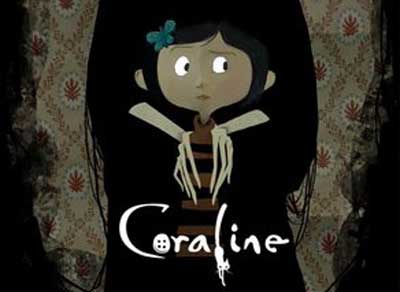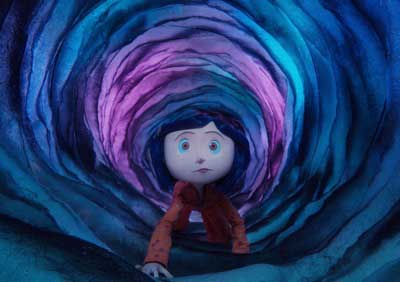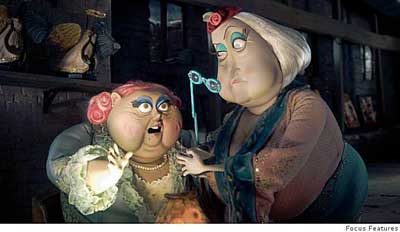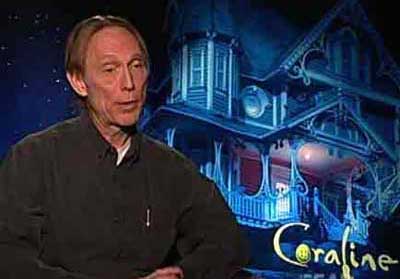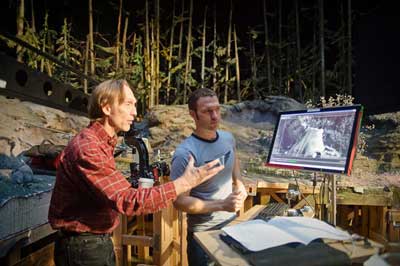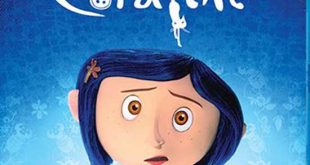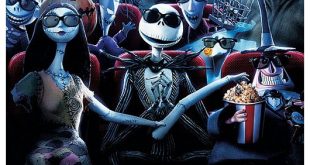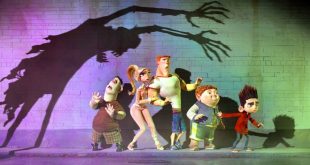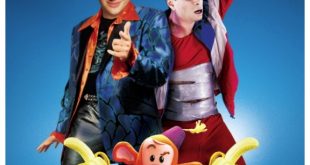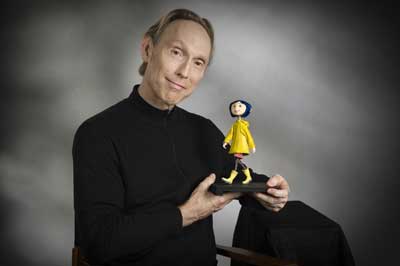 Since he burst on the scene with the wildly imaginative 1993 stop-motion animated feature The Nightmare Before Christmas, California Institute of the Arts graduate Henry Selick has been one of Hollywood’s most innovative filmmakers. After his stop-motion followup to Nightmare, the well-received 1996 film James and the Giant Peach, Selick directed the partially live-action film Monkeybone in 2001. Now, the long-in-the works Coraline, a surreal mixture of animation and fantasy, arrives on DVD on July 21, 2009 after a successful theatrical run that included both traditional and dynamic 3D screenings. In this exclusive interview from his new Portland, Oregon studio base, Laika, Selick reflects on his lauded career and shares special insights into the creation of Coraline, his most ambitious project to date.
Since he burst on the scene with the wildly imaginative 1993 stop-motion animated feature The Nightmare Before Christmas, California Institute of the Arts graduate Henry Selick has been one of Hollywood’s most innovative filmmakers. After his stop-motion followup to Nightmare, the well-received 1996 film James and the Giant Peach, Selick directed the partially live-action film Monkeybone in 2001. Now, the long-in-the works Coraline, a surreal mixture of animation and fantasy, arrives on DVD on July 21, 2009 after a successful theatrical run that included both traditional and dynamic 3D screenings. In this exclusive interview from his new Portland, Oregon studio base, Laika, Selick reflects on his lauded career and shares special insights into the creation of Coraline, his most ambitious project to date.
You’ve moved around quite a bit – born in New Jersey, but since the 1970s, you’ve lived up and down the West Coast. How has this journey worked creatively for you, and why so many moves?
I started out at CalArts [north of Los Angeles in Valencia] and worked at Disney Studios for about four years. Then I moved to the Bay Area in the early 80s to work as a sequence director on [the animated feature film] Twice Upon a Time. That was my base up until Coraline. There, I did the features, MTV stuff, commercials and short films. For Nightmare and James we got warehouse space right in San Francisco south of Market. I went up to Portland, Oregon four-and-a-half years ago to get Coraline going. For Coraline, we built out our little in-house team and tried to do a lot of practical effects. Some of the main armature components were made in San Francisco, but 99% of the movie was all done in one big warehouse in the outskirts of Portland.
How did you decide on Coraline as your first feature since Monkeybone, eight years ago now?
The story comes from the Neil Gaiman book. He sent me the pages as a side project. He’d been working on it to finish for his younger daughter. In the book, the basic story is there. Back in 2000, there was a long period of time where I wrote the screenplay. At that time, I did animated creatures for [Wes Anderson’s feature] Life Aquatic. In all of that time, I’d been living this Coraline story and dreaming the visuals.
The expanded version had already been fully formed in my mind. I had written an early draft, but Neil told me to go off and reimagine it. He said that the book was not quite a film. The second draft of the screenplay is when things came to life. I restructured everything, added characters, and came up with the issue of whether the whole world is a dream. When you are adapting a book, it has to feel like the book and smell like the book. But there are several thousand large changes and a hundred medium ones. I would always come back to the screenplay, do sketches, and do a scrapbook of images. For example, I had come across an obituary of a child star from the 1920s – there was a picture in the paper of her holding a doll that looked just like her that was being marketed to the public. I was collecting images for ideas and had a very long time to assemble the world of the film.
How did you devise the execution of the complicated production process for this film?
There is an order to events but everything overlaps and there are certain things you don’t quite resolve and you go back to. Stop-motion animation is much closer to live action films – you have set construction, lighters, electricians, gaffers, a hair department, and costumes. The difference, of course, is that it’s all miniature with many sets working at the same time with a team of animators. Some of the first steps that happen are to convince people that you can make a movie from your script – then character design and voice casting. Virtually all animation and effects-heavy live-action films are completely storyboarded with temp voices and temp music. In a sense, you are making the movie once, editing it before you actually do any animation. You don’t have a 10:1 ratio – it’s a very close ratio. Then, people storyboard the entire film to get to the next step. You work out the first and second act, and the third act is loosey-goosey.
You have your first scenes figured out, you’ve recorded the voices, start building puppets, and build the world. You experiment with materials and do 3D tests. Eventually, you are testing puppets – how does Coraline walk, what are her poses, what makes her stand out and unique? You figured out the best sync – full replacement faces where you sculpt hundreds of individual faces. You can’t build all of your puppets at once – you start out with a few characters and ramp up to 30 sets at once. You are re-recording pickup lines a year later. You’re hoping Dakota Fanning’s voice [playing lead performer Coraline Jones] doesn’t change that much for the pickup lines.
You hit this sweet spot where you have the whole film mapped out and everyone is making the same film in this very effective machine. You are working with animators who are the real actors, planning shots, having dailies four times a day, and start to work with the composer who sketches out the ideas for themes. You get everything shot and bring in an outside editor who can brutally look over the film with a fresh eye. 18 months is the actual shoot time. The core of the crew working hard every day making the film is 150 people. We have an additional 150 who work for a short period of time. They may have done inspirational artwork or armatures. There is also a big support group and a visual effects team to paint out rigs.
Can you describe your typical day whilst the film is in the throes of production?
We have two edit rooms so that I can ping pong back and forth. We do lighting and camera tests and stand-in puppets. Then you work with the animators. There is a lot of time spent in editorial. Then you go out on the sets checking in on shots. The animators shot digitally so that we can play back what we are doing and respond to it. We are still building final characters to the end. In the heat of it, 60% is editorial and 30% of the day roaming set to set and checking the art department and sound. Everyone thinks that stop-motion is watching paint dry. The actual performance of the animator coaxing performance out of these puppets is slow. But as a director, you are supervising all of the individual animators and supervising and four lead animators. What are the poses, walks and motions for the characters? I am very much talking through performance with the animators, timing, and posing of every scene. That is how I spend the majority of my day.
How is the type of animation that you are doing for Coraline different from what pioneers Willis O’Brien and Ray Harryhausen created in King Kong (1933) and Mighty Joe Young (1949)?
It’s different in that I have a much larger number of people, but at the heart of it, it’s exactly the same – the ball and socket hinge joint puppet posed a frame at a time – 24 times a second – to get the illusion of movement. The process is identical. On top of that, we are shooting digitally. Back on Nightmare and James, we had to send our footage to the lab. Now, if a puppet breaks in the middle of a shot, we can get the puppet repaired. We have digital assisting. We can put the puppets on a simple metal rig and hand animate and later paint out the rig. We can also program camera moves. At the very center of it, it’s the same. Harryhausen and Willis O’Brien are true pioneers who carried a huge amount of weight on their own. Before Coraline, we had 17 assistants, which seemed like a huge number.
How would your describe your working relationship with Tim Burton, who produced your film The Nightmare Before Christmas?
Tim had developed this basic idea inspired by How the Grinch Stole Christmas and rewrote is as a nightmare. He deserves credit for the clashes of holiday worlds. I partly inspired the character of Jack Skellington. Tim did a drawing of the main characters and Rick Heinrichs sculpted them. We presented them at Disney in the 80s and they thought it was too weird. No one was sticking around. Tim had to leave to make feature films. I did my first stop-motion in 1978 that was funded by AFI. Fast-forward to Tim having huge success. He had seen my work for MTV – station IDs. Rick got Tim and me together to direct. I spent three-and-a-half years growing a team, and I did my films with a very talented team. Then Tim made Batman Returns. The film was called A Nightmare Before Christmas till a month before it came out. It was unsettling for it to be changed to Tim Burton’s A Nightmare Before Christmas. Tim is a genius and gave me my break, but I think he couldn’t stand to not take more credit. With Coraline, I got the creative support that I had before Nightmare.
How did Danny Elfman become integrated into not only the music but songs and story elements as well?
Danny Elfman was chosen to do the music for Tim’s first feature by Paul Reubens, and Tim and Danny hit it off, so that it definitely a Tim choice to work with Danny again. He has done 90% of the music of Tim’s films. Danny is a huge contributor of story – for the songs, Tim would say that we could use a song here and Danny would make up what he felt was right. We started the movie before there was a finished screenplay. Danny wrote three songs. The writer was ill and later the screenplay was written by Caroline Thompson who strung the songs together. Danny deserves a third of the credit at least for the creative spirit of the film.
Aside from your conflict with the release title, how was your experience making your first directorial feature with Nightmare?
It was incredibly joyful experience making the film. We had previously only been able to make 5-6-minute short films. To get to make a stop-motion feature was such a gift. Everyone was so goddamned happy every day. We were also fearless. We didn’t worry about the success or failure – we wanted to make the film as good as we could. It was a low-budget film to lure Tim back to Disney. But the real gift to Disney was Nightmare. We had a lot of fun coming up with those characters and figuring out their personalities. That world was the easiest in many respects. That’s where people had the most fun. There was the real world, and then Christmastown which was Seussian world. Tim has always said that Dr. Seuss is his favorite artist of all time.
Do you shoot tests to see if potential investors/distributors might be interested in making your films?
You do character designs and possibly an animation test. For Nightmare, we did a test – we built a very simple Jack Skellington with a wire armature. The people at Disney scratched their heads. Tim Burton was positive, and they thought the test was a small price for this curiosity. At Laika, we did shoot tests for Coraline. We used an existing character from another short film. Honestly, most people couldn’t even tell the difference. I took Coraline to the former head of Fox who responded well. It took us a long time to get the film financed. Travis Knight [President and CEO of Laika] wanted to do it as a stop-motion feature, and I wanted to shoot 3D. Even if you get a green-lit film, you are going to do tests for yourself, getting the look of it.
How difficult is it for you at this juncture to launch a new feature film project?
I’m at a great point right now. For a number of years, it was very difficult to get funding for stop-motion films. Between Nightmare and James, Toy Story came out. In the ensuing years, it was virtually impossible. No one just wants to make a profit – they want to make a huge profit. Then Aardman animation got another film going. Tim Burton got Corpse Bride, so things circled back and the timing was great for Coraline. People come to visit us and they see several hundred people in the credits. They can’t believe it’s not done in China. It’s still about 1/3 the cost of Pixar and DreamWorks computer-animated films. These films don’t date, because they are already out of time. It’s a good time for me. The major European countries are opening. People send me books and scripts. Right now is the easiest time to get a film set up and made. You can sell one on a pitch and the screenplay. But I haven’t figured out what I am doing next.
What was ultimately your greatest challenge in making Coraline?
There is no one single thing. Getting Coraline made and holding onto the scary elements was a huge challenge. At various times our distributor and main producer, Bill Mechanic, for him, animation has fit into this one type of storytelling. Just trying to make a scary film for kids was quite a challenge for Coraline. I would like to start pushing the boundaries of what animation could be as in Pixar films. The new film Up is pretty astonishing in the emotional content of the lead character. There is a movement afoot to keep pushing the boundaries. I wouldn’t want to do another scary film for kids, but if I do, there would be a new element. Animated animals have been at the forefront since the beginning. There are new types of stories to tell with higher-level drama and less jokes. I like to make films for kids but something that is for everyone – also appropriate for kids but not safe. I couldn’t be happier with having made Coraline.
Scott Essman has been writing about crafts and craftspeople in the entertainment business since 1995. His book, Tim Burton – An American Original is due in 2010 from Praeger Publishing.
Interview: Henry Selick – Director (Coraline)
 Horror News | HNN Official Site | Horror Movies,Trailers, Reviews
Horror News | HNN Official Site | Horror Movies,Trailers, Reviews
